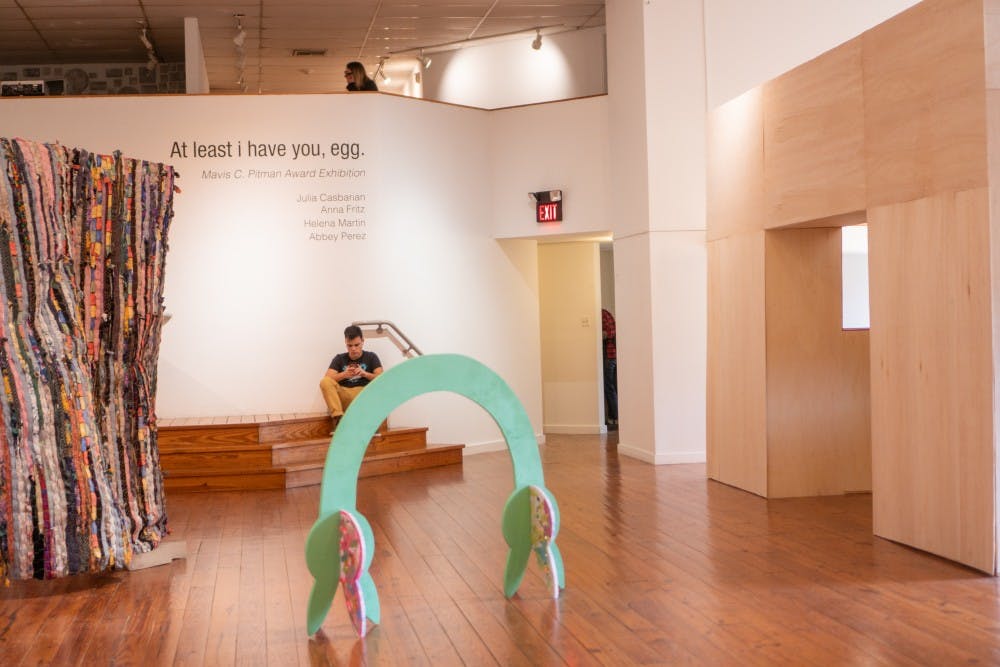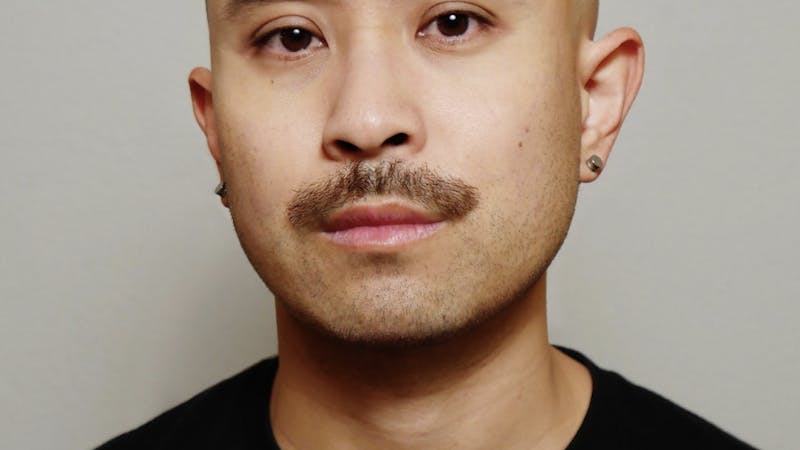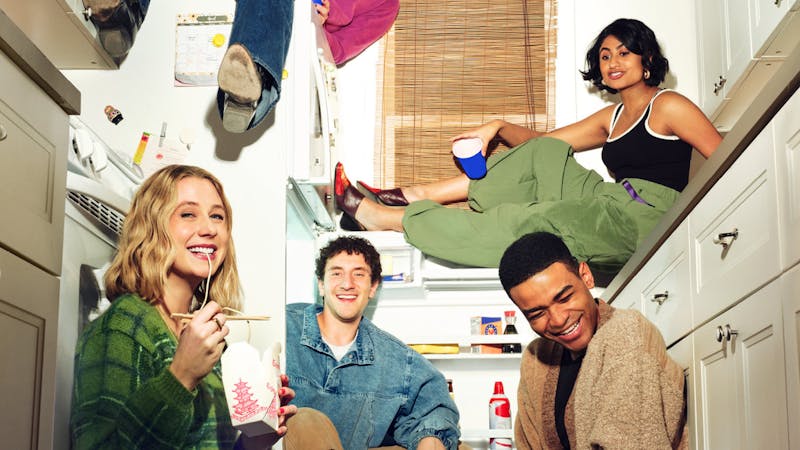‘At least i have you, egg.’ brings whimsical student art to the Media Center

A series of illustrations drawn onto eggs have replaced the old film advertisements that typically line the walls of the Rice Media Center. They provide a quirky first impression for visitors and serve as the introduction to “At least i have you, egg.”, the 2019 Mavis C. Pitman Exhibition.
Each year, the Mavis C. Pitman Exhibition Fellowship sponsors visual and dramatic arts students by funding and hosting an original body of their work in the Rice Media Center. This year, students Julia Casbarian, Anna Fritz, Helena Martin and Abbey Perez bring a diverse body of work for viewing, engaging and questioning. The students were picked individually through an application process and provided grants to create their work.
And what about the eggs?
“Anna had ‘At least I have you, egg.’ written on a piece of paper and we all just thought it was funny,” Casbarian, a Baker College junior, said. “Our pieces are all so different that it made sense to use a completely unrelated title.”
Upon entering the Media Center’s main gallery, viewers are confronted with Casbarian’s and Fritz’s large sculptural works. To the right, Casbarian’s “Telefrag” imitates a cat’s play place and features a winding path formulated by hand-woven walls. Bright colors and wire peek out from every curve of “Telefrag”, culminating in a playful bunny sculpture to the front of the piece. According to the exhibit’s handout, “Telefrag” seeks to “transport human viewers into the world of a cat,” consequently shrinking the viewers’ gaze.

“I made a small sculpture in class that was two plaster bunny heads connected by a plastic purse handle, which really reminded me of teleportation accidents in cartoons, especially one episode of SpongeBob [SquarePants],” Casbarian said. “When I decided to make a giant cat play space, I thought it fit perfectly with this idea of a teleportation machine, so I just went with it very naturally.”
Casbarian also said that she intends for viewers to interact with the sculpture and come away with their own conclusions through their activation. One interesting aspect of the sculpture is a window, left at a lower height in the sculpture. When peering through it, viewers can glimpse a literal window into Fritz’s piece, which stands adjacent to “Telefrag.”
Fritz designed and built “Zwischenraum,” a tall wooden set that viewers can also walk through. Resembling a gallery space, “Zwischenraum” is born from a critique of boring, staid gallery spaces.
“I came up with my concept for “Zwischenraum” in a sculpture class last year,” Fritz, a Baker junior, said. “The prompt was to design an art exhibition for the Rice Art Gallery. Instead of using paintings and sculptures to fill the space, I became fascinated with the idea of creating false exhibition walls to create a new gallery experience, which would be entirely void of traditional art works.”
Fritz, who is also majoring in art history and architecture, said that she finds the museum experience to be highly individual and sometimes boring, an experience that she expects when entering galleries. “Zwischenraum” seeks to challenge this dematerialization of artwork, confronting viewers with a blank gallery wall and only solid colors to entertain them.
“I kept envisioning a scene of people entering a gallery and seeing nothing but gallery walls and empty frames and not knowing what to do,” Fritz said. “I thought this might offer a new way of approaching ‘artworks,’ where visitors were confronted with a spatial experience as opposed to any clear object to look at.”
The Media Center doesn’t seem to suffer the same problem of gallery monotony — viewers can move from Fritz’s and Casbarian’s dynamic pieces to Martin’s and Perez’s, located upstairs. Perez’s “VHS, CRT, Celluloid, Remixed” installation features a set of stacked televisions playing remixed, bleached film. On the handout, Perez credits “everyone on eBay who sold me lots of 500 floppy tapes, and more without batting an eye.”
“I took Handmade Film last semester, which is all about working with 16-millimeter film, and I discovered that I really like hand-editing film,” Perez, a Wiess College senior, said. “I got the idea for this project when I was sitting in class in the Media Center and there was an old TV monitor in front of the screen. Dr. [Tish] Stringer was pulling up a YouTube video, and for a moment the play button was projected onto the side of the monitor. I just thought it was a cool image, and it started me down the rabbit hole that led to this project.”
Perez took this accidental inspiration to heart, hand bleaching and painting 16-millimeter film. She mapped the film clips using theater technology in an effort to bring new life to a medium that may otherwise be considered outdated.
“I know that I have grown up in the digital age, so a lot of analog stuff seems to me like it's less convenient or extremely outdated,” Perez said. “But I wanted to give all the old stuff that I found a new life and use it in a way that it was never intended to be used.”
Behind Perez’s installation lurks a somewhat ominous entrance to Martin’s work, “Push/Pull.” Hosted in its own separate room, “Push/Pull” was inspired by projected forms: shadow puppetry, magic lanterns and slide shows. The installation is composed of floating paper lanterns, onto which geometric, animated and abstract shapes are projected. Martin said that they intended to emphasize the physical nature of projection and light.

“When you’re projecting an image, you work with a surface which you illuminate, and the areas which do not have light on them create the image,” Martin, a Lovett College senior, said. ‘Push/Pull’ is meant to pull at the boundary between illuminated and illuminating. Because the projection surfaces of my installation are lanterns, the viewer is made aware of the luminescence of the medium.”
Although all four artists were chosen independently, the four installations create interesting dialogues between each other.
“Our pieces are all very different, but I think that’s the beauty of the Pitman show,” Casbarian said. “It wasn’t a conscious choice to be different, but we all came up with our ideas separately so all of our pieces were very different because of that.”
“At least I have you, egg.” is on view at the Rice Media Center until March 28. The center is open from 9 a.m. - 5 p.m., Monday to Friday.
More from The Rice Thresher

Andrew Thomas Huang puts visuals and identity to song
Houston is welcoming the Grammy-nominated figure behind the music videos of Björk and FKA twigs on June 27.

Live it up this summer with these Houston shows
Staying in Houston this summer and wondering how to make the most of your time? Fortunately, you're in luck, there's no shortage of amazing shows and performances happening around the city. From live music to ballet and everything in between, here are some events coming up this month and next!

Review: 'Adults' couldn’t have matured better
Sitcoms are back, and they’re actually funny. FX’s “Adults” is an original comedy following a friend group navigating New York and what it means to be an “actual adult.” From ever-mounting medical bills to chaotic dinner parties, the group attempts to tackle this new stage of life together, only to be met with varying levels of success.

Please note All comments are eligible for publication by The Rice Thresher.